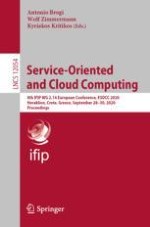This book constitutes the refereed proceedings of the 8th IFIP WG 2.14 European Conference on Service-Oriented and Cloud Computing, ESOCC 2020, held in Heraklion, Crete, Greece, in September 2020.
The 6 full and 8 short papers presented in this volume were carefully reviewed and selected from 20 submissions. The main event mapped to the main research track which focused on the presentation of cutting-edge research in both the service-oriented and cloud computing areas. In conjunction, an industrial track was also held attempting to bring together academia and industry through showcasing the application of service-oriented and cloud computing research, especially in the form of case studies, in the industry.
The chapters ‘Identification of Comparison Key Elements and their Relationships for Cloud Service Selection’ and ‘Technology-Agnostic Declarative Deployment Automation of Cloud Applications’ are available open access under a Creative Commons Attribution 4.0 International License via link.springer.com.
